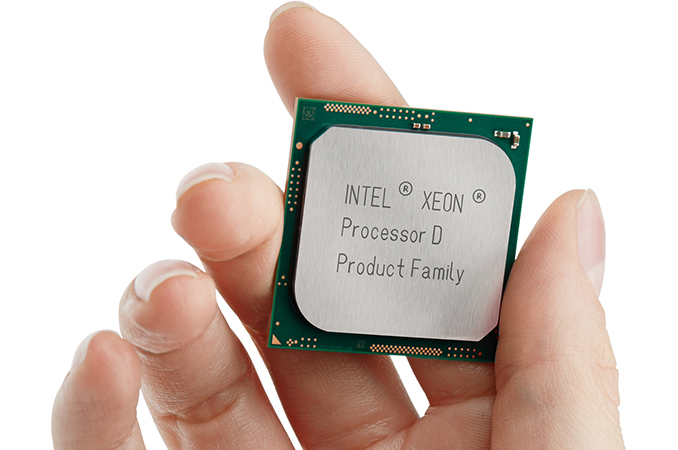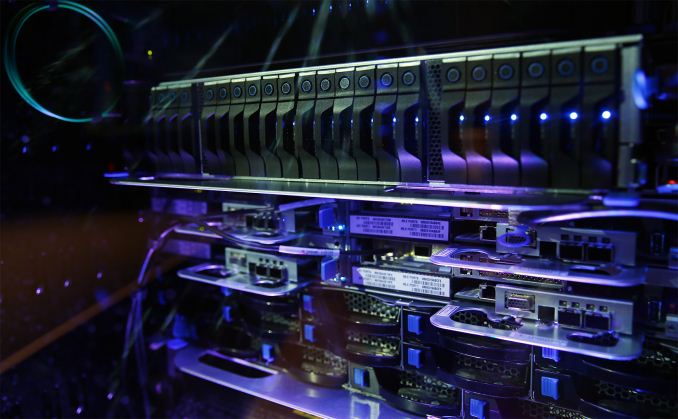Intel Announces Xeon D-1500 Network Series SoCs with QuickAssist, Four 10 GbE Ports
by Anton Shilov on February 26, 2017 11:59 AM EST- Posted in
- CPUs
- Intel
- 10G Ethernet
- Enterprise
- SoCs
- Xeon-D
- Broadwell-DE
- QuickAssist

Intel’s Xeon D SoCs and supporting platforms for storage, web hosting and networking applications seem to be getting traction with actual hardware manufacturers as well as end users. This month Intel announced expansion of the lineup of these processors with several new models supporting QuickAssist accelerator and increased amount of 10 GbE ports. The new Xeon D SoCs for networking applications simplify creation of various devices due to higher integration.
The newest Intel Xeon D-1500-series products use Intel’s prowess in highly integrated SoCs, this time powered by up to 16 of the company’s high-performance Broadwell cores, featuring a dual-channel DDR3L/DDR4 memory controller as well as rich I/O capabilities (up to 24 PCIe 3.0 lanes, 6 SATA ports, two 10 GbE ports, USB, etc.). The Xeon D SoCs support the majority of RAS capabilities of the Xeon E5 v3 processors, including ECC, MCA, PCIe ECRC (end-to-end CRC), SMM and so on. At present, Intel offers two application-specific lineups of its Xeon D SoCs: for web hosting servers and for networking devices. The latter is going to receive several new models with improved feature-set in the coming months.
Firstly, Intel plans to integrate its QuickAssist accelerator with up to 40 Gbps of compression/encryption throughput into the new Xeon D SoCs. Today, developers of network equipment have to use Intel’s discrete QuickAssist hardware to speed up compression/encryption operations, which means larger footprint, higher power consumption and additional costs. The integration of the accelerator will enable designers to reduce dimensions of their motherboards and will reduce power consumption a bit, assuming they can feed it. Since Intel does not announce prices of the new SoCs right now, it is hard to tell how the integration affects the cost of the platforms (Intel does not mention that in its documents), but usually the elimination of one component can lead to the elimination of some other parts too, so BOMs get lower.
Secondly, Intel intends to integrate four 10 GbE controllers (at present, we do not know whether they can be grouped for 40 Gbps or split for 2.5 or 5 Gbps ports) into the new Xeon D SoCs, doubling the amount of 10 GbE ports supported by today’s Xeon D processors. Obviously, for applications that need over four 10 GbE ports, Intel’s FM10000 Ethernet PHYs will still be required, but for other devices having the integration will help to reduce extra chip count. Again, the integration here could mean a reduced footprint, lower chip count and power consumption.
The new Intel Xeon D-1500 SoCs with enhanced networking capabilities are currently sampling with Intel’s customers. The chipmaker expects its clients to start launching their products based on the new processors by mid-2017.
(Ian: It's worth noting that Xeon D-1500, as a family, has been around for a few years now. No news yet on updates to Xeon-D using Skylake or Kaby Lake cores.)
Related Reading:











11 Comments
View All Comments
Michael Bay - Sunday, February 26, 2017 - link
On an unrelated note, I`d like to know when Kaby Lake chipset and MB roundup is coming. Is it coming at all?RaichuPls - Sunday, February 26, 2017 - link
We haven't gotten a 1050/1050 Ti review, the Apple A10 deep dive, or a 950/960 review yet...Michael Bay - Sunday, February 26, 2017 - link
I bought 980 eventually, so 960 is forgiven!Mavendependency - Monday, February 27, 2017 - link
Weren't the A10 and E8890 deep dives cancelled because Andrei resigned?Dug - Tuesday, February 28, 2017 - link
Apparently it's buried in tweets, which for some unknown reason is very hard to follow.Oh that's right, a website shouldn't be a tweet fest.
Comdrpopnfresh - Sunday, February 26, 2017 - link
smells like beefier bin of the same base architecture that is the Atom C3000. even the review read the same- I thought it was a duplicate.The Von Matrices - Monday, February 27, 2017 - link
If the pricing is right, this could make a great CPU for a homebrew 10GbE router. Currently the cheapest 4+ port 10GbaseT switch is $800 and good luck finding a consumer grade router that can handle more than 1Gbps. If this CPU can be had for under $600 I may be building a Debian router based on it.Dug - Tuesday, February 28, 2017 - link
The reason for no consumer grade router with over 1Gbps is because there isn't a demand or ISP offering more. Never mind the heat and weight. Nor has there been an up cry for internal routing. 99.99% of consumers use a flat network.What people may want is a 10Gb switch behind the router.
Dug - Tuesday, February 28, 2017 - link
Forgot to add, most houses aren't equipped for 10Gb anyway. We've even had problems in our office with cables and cable lengths. It is not as plug and play as 1Gb. It would be a support nightmare for any company.evancox10 - Monday, February 27, 2017 - link
"Obviously, for applications that need over four 10 GbE ports, Intel’s FM10000 Ethernet PHYs will still be required, but for other devices having the integration will help to reduce extra chip count."I think you'll be needing some PHY chips regardless, the SoC itself only contains down to the MAC layer. Unless you're doing backplane Ethernet, you would have either an SFP+ (fiber) or 10GBASE-T (copper RJ45/CAT6) PHY chip(s) to actually drive over the line.